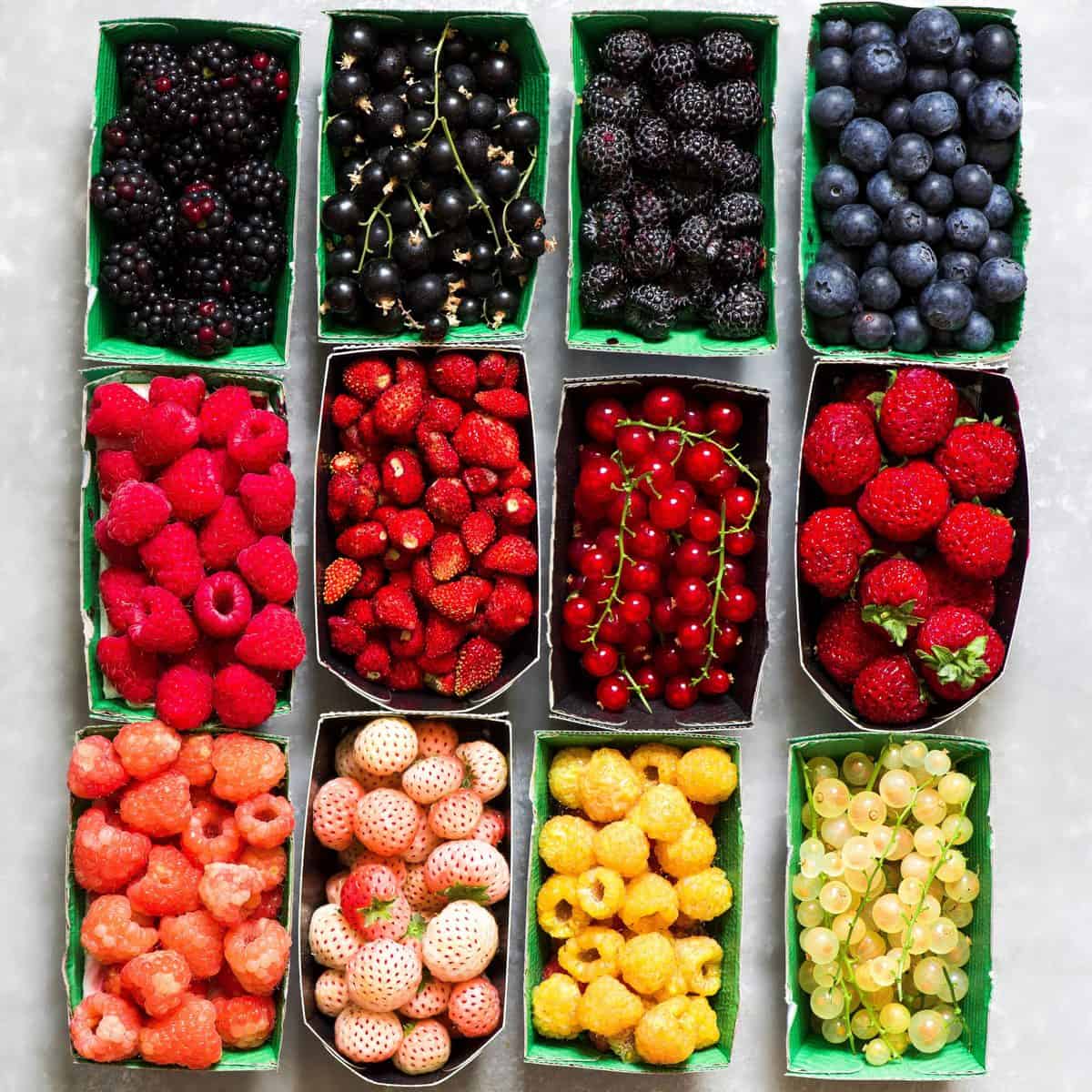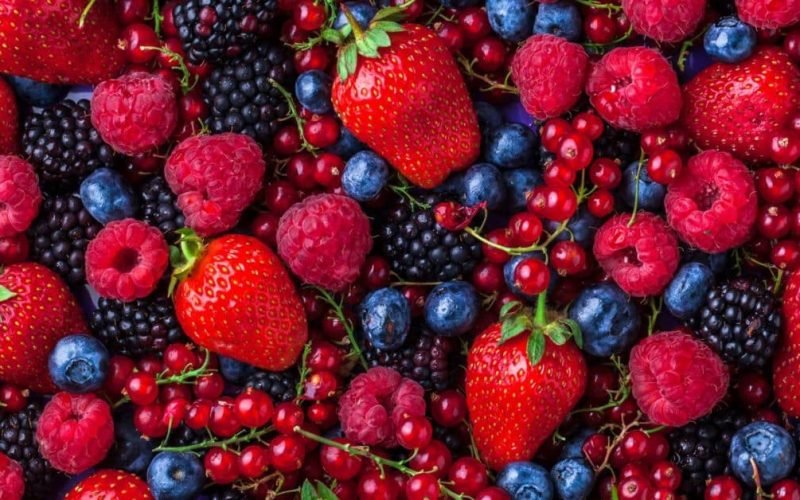There are different types of berries, many of which are delicious and useful. Vitamins, minerals, antioxidants, and other nutrients are abundant in many berry types.
Blueberries, raspberries, and blackberries are some of the healthiest berry types.
The health advantages of several exotic berry types, such as goji and acai, are also well-known.

Below are the different types of berries.
1. Strawberries
The strawberry is one of the most well-known berries extensively produced in regions with cold climates.
The strawberry fruit is bright red, has an intriguing scent, and is juicy with a touch of sweetness.
As with raspberries, strawberries are usually regarded as berries despite their flesh comprising a large flower receptacle and several fruits, referred to as achenes.
The strawberry plant, which yields the fruit, is a vine-type plant.
Health enthusiasts may rely on this fruit since it includes the key immunity-boosting nutrients, manganese, and vitamin C.
Strawberries may be used in various ways, including ice cream, pastries, and a delectable strawberry shake.
2. Red Currants and Black Currants
Bright red berries called red currants grow in bunches like grapes. The size of redcurrants is comparable to that of blueberries, and they have a tart, acidic flavor with a little sweetness.
These currant varieties’ astringent flavor might make your tongue feel slightly dry but not as dry and bitter as chokeberries.
Red currants are one of the different types of berries that are very beneficial to your health since they are a high source of antioxidants.
However, research has found that black currants have higher anthocyanin levels than red currants.
3. Cranberries
Red berries with a sour flavor, known as cranberries, are high in vitamin C, fiber, and antioxidants. Cranberries naturally grow on vines near the ground in bogs.
In addition to being marketed as dried berries, cranberry fruits are used to make juice and jam.
Cranberry products often have extra sugar because of the cranberries’ very sour flavor.
Cranberries have high levels of the antioxidants flavanones, anthocyanins, and flavonols, which give them a bright red color.
To help prevent urinary tract infections, cranberry juice is often consumed.
Cranberries seem to have a minor antibacterial action and may aid in treating urinary system problems.
4. Bilberries
In terms of appearance, bilberries resemble blueberries since they are both dark-blue fruits. However, bilberries are low-growing shrubs from the Vaccinium family.
In addition, it has a stronger taste and is softer and juicier than blueberries. It is also known as European blueberry since it is a berry of European origins.
Natural antioxidants and other minerals abound in bilberry fruits. It also includes advantageous substances that may be used to treat inflammation and lower blood sugar.
Additionally, bilberries may aid in improving heart and eye health. Additionally, it claimed that it might enhance mental capabilities and combat ulcer-causing germs.
5. Salmon Berries
Salmonberry is a type of bramble that belongs to the rose family and is native to the west coast of North America.
It was found near the mouth of the Duckabush River in Jefferson County, Washington.
Its shrub may reach a height of 13 feet and has a body system coated with tiny prickles.
Its flower has a pinkish-purple tint with five petals around 3 cm in diameter, making it easy to identify.
Salmonberries have a structure similar to raspberry and are edible. You may consume it unprocessed or turn it into sweets, jams, jellies, or wine.
The name “Salmonberries” comes from the fact that this fruit is often paired with Salmon.
These fruits are also being used as an ingredient in many dishes. It is one of the best different types of berries.
6. Blueberry
Due to their juicy flesh and sweet flavor, blueberries are often at the top of the list of the best different types of berries that are dark in color.
Blueberries are loaded with vitamins and antioxidants, much like the majority of dark berries like blackberries.
According to studies, anthocyanins, the colorant that gives berries their color, have been found in blueberries to support healthy eye health.
In addition to being rich in fiber and vitamins C and K, blueberries are also low in fat.
Dark berry fruits like blueberries and blackberries positively impact cardiovascular health, according to studies.
The fact that blueberries decrease cholesterol is one of the health benefits of consuming them.
7. Goji Berries
Goji berries may not be as well-known as some of the different types of berries on this list, but they are just as healthy.
These berries, which are dark red, also contain more beta-carotene than typical carrots, germanium, and other nutrients.
Goji berries have been associated with improved responses to cancer therapies when ingested by patients, much like many other berries on this list.
Additionally, they may aid with liver contamination protection. The way goji berries affect the brain is another intriguing quality.
Goji berries, like blueberries, have shown the capacity to raise emotions of well-being and enhance cognitive function considerably.
In one research, taking goji berries for only two weeks resulted in good effects.
8. Elderberry
Another fruit on the list of the different types of berries that are good for you is the elderberry.
However, these little black fruits shouldn’t be consumed uncooked, in contrast to many other beneficial berries.
One of the healthiest berries to eat may be elderberries. Elderberries are a fantastic source of healthful nutrients and are high in vitamins C and A.
You may make elderberry tea or syrup to include these tiny blackberries in your diet.
According to some research, Elderberry syrup may help treat colds and other upper respiratory infections.
The anthocyanins in elderberry are healthy for your heart and may help strengthen your immune system, similar to the health advantages of other dark berries.
9. Raspberries
Raspberries, like blackberries and strawberries, are aggregate fruits because they have several seeds from various ovaries of a single flower. It originated from the Rubus genus of rose plants.
There are many different types of them; nevertheless, red raspberries are the most popular. They are a major fruit crop that is grown all over the world.
Raspberries are a great food for those trying to lose weight since they are low in calories but abundant in fiber, vitamins, antioxidants, and minerals.
These phytonutrients have anti-aging characteristics and are important in the battle against several diseases, including diabetes, cancer, and arthritis.
Raspberries may be eaten fresh if you wish to use them as a substitute healthy snack or as part of your detox routine.
However, because raspberries have a lot of sugar, eating them in moderation may help you control your weight.
10. Huckleberry
Huckleberries and blueberries have a striking resemblance that makes them easy to mix up.
They are also known as bilberries and the European blueberry in certain regions.
In contrast to other different types of berries, huckleberries are more often found in their natural habitat.
The seeds are a noticeable distinction between blueberries and huckleberries. Huckleberries contain fewer carbohydrates and less sugar than blueberries.
However, huckleberries are high in fiber and antioxidants, much like most dark berries.
If you want to cut down on your consumption of carbohydrates, you may substitute huckleberries for blueberries in your diet.
11. Gooseberries
Gooseberries are tiny fruits that develop on bushes and weigh just 3 to 6 grams each.
The fruit may be green, yellow-white, red, pink, or dark purple, depending on the plant variety.
Regarding the tastes, they might be either sweet or tart. Fruits may have a sour flavor if eaten before they are fully ripe.
Gooseberries include antioxidants, phytochemicals, and vitamins E and C, among other nutrients.
They strengthen the immune system and aid with brain functions.
They can also combat type 2 diabetes, certain cancers, heart disease, and the effects of aging.
To get the full health advantages of gooseberries, consume the fruits raw.
However, some people would rather use them as an ingredient in their dishes or to prepare gooseberry juice than consume them raw.
12. White Mulberries
Although it originated in China, the white mulberry was brought to North America in the 1600s.
This plant, also known as Morus Alba, grows quickly and may reach heights of ten to twenty meters. Its size ranges from tiny to medium.
White mulberries have a flavor comparable to blackberries, which is somewhat sweet and low in acidity.
Patients with diabetes may benefit from this type of berry as a medication.
It also includes vitamin C and minerals that effectively treat excessive cholesterol, high blood pressure, and even the common cold symptoms.
Pick a white mulberry, just a little overripe, for the best flavor.
13. Chokeberries
Aronia berries, often known as chokeberries, are sour berries that resemble blueberries but are much darker and nearly black.
Chokeberries have a high tannin level, making them one of the berries with the most-bitter flavors.
After eating these blackberries, your mouth could feel dry and bitter. Most people don’t consume fresh chokeberries due to their bitter flavor.
Instead, they use them to produce syrups, jams, teas, and baked products.
Although chokeberries are a type of blackberry, red chokeberries are also available.
Chokeberries may be among the best different types of berries for enhancing cardiovascular health.
These dark berries’ antioxidant content lowers cholesterol, blood pressure, and inflammation.
Chokeberry extracts may be purchased as a powder if you find chokeberries to be too bitter to consume.
14. Red Mulberry
Morus rubra, referred to as the red mulberry, is a common plant in Ontario, Vermont, Minnesota, and South Florida regions.
Additionally, you may locate them in the western states of central Texas, South Dakota, Nebraska, and Kansas.
However, eastern and central North America is the berry’s natural habitat.
In contrast to the mulberry, which has bright green, shining leaves, it has dark green, rough, and dull leaves.
This plant is sensitive to fire but may survive and even grow after a fire if provided adequate moisture and water.
Red mulberries taste similar to raspberries and are quite delicious. You may prepare cakes and other delicacies with them.
Additionally, it may be made into a jam or even a wine. The red mulberry not only tastes excellent but also has antioxidants like vitamins C and K. Native Americans also used the tree’s sap to treat several diseases.
15. Acai Berries
Acai berries are one of the best different types of berries. Reddish-purple and inch-long acai berries are round in shape.
Although it is mostly grown in Central and South America, this delicious fruit is now grown in other places.
According to studies, acai has a greater antioxidant level than other berries, including blueberries, cranberries, raspberries, and blackberries.
Due to their greater antioxidant content, Acai berries ought to provide many health advantages.
These antioxidants benefit the heart, brain, and general health. In addition, the fruit has beneficial fatty acids and nutritious fiber.
This fruit is a wonderful option if you’re trying to lose weight since its fibers have been shown to reduce hunger.
There are more than 400 different species of berries that come in many different colors ranging from yellow, red, purple, white, and blue.








